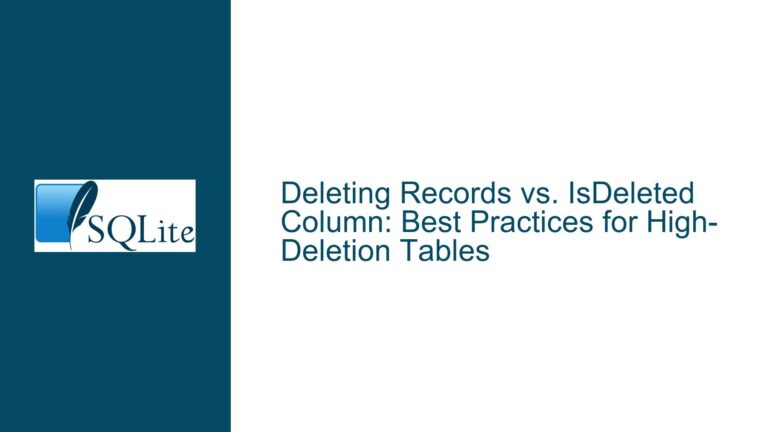Exploring SQLite Performance Optimization: File Format Trade-offs and Alternatives
Understanding SQLite’s Performance Constraints and Optimization Goals
SQLite is renowned for its lightweight design, portability, and robustness, making it a popular choice for embedded systems and applications requiring a local database. However, its performance characteristics are deeply tied to its file format and internal algorithms, which prioritize compatibility, reliability, and simplicity. While SQLite is already highly optimized, there are ongoing discussions about whether further performance gains can be achieved by rethinking its file format and internal data structures. This post delves into the nuances of SQLite’s performance, the trade-offs involved in altering its file format, and potential alternatives for achieving higher performance.
The Role of File Format in SQLite’s Performance
SQLite’s file format is a critical factor in its performance. The format is designed to balance storage efficiency, reliability, and compatibility. However, some argue that the current format could be optimized further for specific use cases, such as in-memory databases or scenarios where large caches are available. The file format’s design choices, such as the use of variable-length integers (varints) and the organization of table and index pages, have significant implications for both storage efficiency and processing speed.
One of the key challenges in optimizing SQLite’s file format is the trade-off between storage efficiency and processing speed. For example, varints are used to compactly store integers of varying sizes, but they require additional processing to decode. Similarly, the organization of table and index pages is designed to minimize storage overhead, but this can lead to suboptimal cache utilization and increased I/O operations. These trade-offs are particularly relevant in performance-critical applications where reducing latency and maximizing throughput are paramount.
Another consideration is the impact of file format changes on backward compatibility. SQLite’s file format has remained stable for decades, ensuring that databases created with older versions of the library can still be used with newer versions. This stability is a key feature of SQLite, but it also limits the extent to which the file format can be optimized for performance. Any changes to the file format would need to be carefully designed to maintain compatibility or provide a clear migration path for existing databases.
Potential Causes of Performance Bottlenecks in SQLite
Several factors contribute to SQLite’s performance characteristics, and understanding these factors is essential for identifying potential bottlenecks. One of the primary causes of performance bottlenecks in SQLite is I/O latency. SQLite is designed to be ACID-compliant, which means that it must ensure data durability by writing changes to disk at specific points, such as during transaction commits. This can lead to significant I/O overhead, especially in write-heavy workloads.
Another potential bottleneck is the use of varints for storing integers. While varints are efficient in terms of storage, they require additional processing to decode, which can impact performance in CPU-bound scenarios. Additionally, the organization of table and index pages can lead to suboptimal cache utilization, as the current format may not take full advantage of modern CPU caches and SIMD (Single Instruction, Multiple Data) instructions.
The use of B-trees for indexing is another factor that can impact performance. While B-trees are a proven data structure for indexing, they may not always be the most efficient choice for all workloads. For example, in scenarios where the data is mostly read-only or where the index keys have a high degree of commonality, alternative data structures or compression techniques could potentially offer better performance.
Finally, SQLite’s single-threaded design can be a bottleneck in multi-threaded applications. While SQLite supports concurrent access through its WAL (Write-Ahead Logging) mode, it is still fundamentally designed for single-threaded operation. This can limit its performance in scenarios where multiple threads need to access the database simultaneously.
Strategies for Improving SQLite’s Performance
Given the potential bottlenecks discussed above, there are several strategies that can be employed to improve SQLite’s performance. These strategies range from configuration changes and optimizations to more radical alterations of the file format and internal algorithms.
One of the simplest ways to improve SQLite’s performance is to adjust its configuration settings using PRAGMAs. For example, disabling synchronous writes (using PRAGMA synchronous=OFF) can significantly improve write performance by reducing the number of fsync() calls. However, this comes at the cost of reduced durability, as the database may be left in an inconsistent state in the event of a crash. Similarly, increasing the cache size (using PRAGMA cache_size) can improve read performance by reducing the number of disk I/O operations.
Another strategy is to optimize the schema and queries. Proper indexing is crucial for achieving good query performance, and adding indexes to frequently queried columns can significantly reduce the number of disk reads required. Additionally, batching inserts into transactions can reduce the overhead of committing each individual insert, leading to better write performance.
For more advanced optimizations, it may be necessary to consider changes to the file format and internal algorithms. One potential approach is to introduce alternative page formats that are optimized for specific use cases. For example, a page format that uses fixed-length integers instead of varints could improve performance in CPU-bound scenarios. Similarly, a page format that organizes data in a cache-friendly manner could improve performance in scenarios where large caches are available.
Another approach is to introduce compression techniques for index keys. For example, in scenarios where the index keys have a high degree of commonality, it may be possible to store only the differences between adjacent keys, reducing the storage overhead and improving cache utilization. However, this approach would require careful design to ensure that it does not negatively impact insert and update performance.
Finally, for applications that require extreme performance, it may be worth considering a fork of SQLite that focuses on performance at the expense of compatibility. Such a fork could introduce radical changes to the file format and internal algorithms, such as using SIMD-friendly data structures or alternative indexing schemes. However, this approach would require significant effort and would likely result in a database that is no longer compatible with standard SQLite.
Conclusion
SQLite’s performance is the result of careful design choices that balance storage efficiency, reliability, and compatibility. While it is already highly optimized, there are still opportunities for further performance improvements, particularly in scenarios where compatibility can be sacrificed. By understanding the trade-offs involved in altering the file format and internal algorithms, and by carefully considering the specific requirements of the application, it is possible to achieve significant performance gains. Whether through configuration changes, schema optimizations, or more radical alterations, there are many paths to improving SQLite’s performance, each with its own set of trade-offs and considerations.






